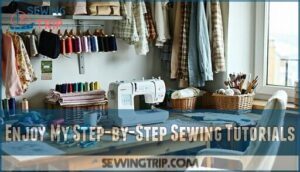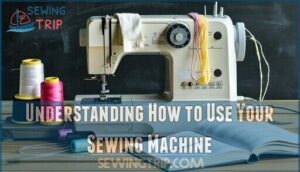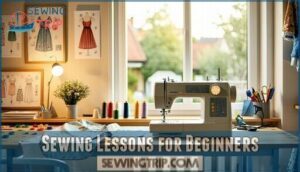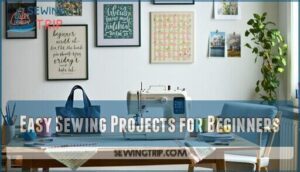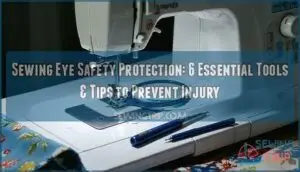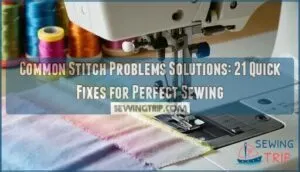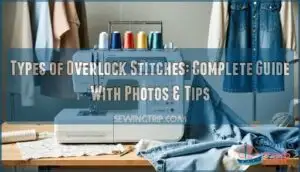This site is supported by our readers. We may earn a commission, at no cost to you, if you purchase through links.
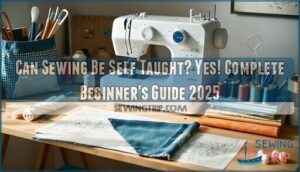 Yes, sewing can absolutely be self-taught! You don’t need formal classes to master this rewarding skill.
Yes, sewing can absolutely be self-taught! You don’t need formal classes to master this rewarding skill.
With online tutorials, pattern instructions, and practice, you’ll develop muscle memory and confidence. Start with basic stitches and simple projects like pillowcases or tote bags.
Modern sewing machines are user-friendly, and countless YouTube channels offer step-by-step guidance. The key is patience—expect some wonky seams initially, but that’s part of the learning curve.
Many successful sewists started exactly where you are now, fumbling with thread tension and wondering why their fabric keeps bunching up. The beauty of self-teaching lies in learning at your own pace and discovering techniques that work for your unique style and goals.
Table Of Contents
- Key Takeaways
- My Sewing Machine
- Learn How to Sew
- Enjoy My Step-by-Step Sewing Tutorials
- How to Use a Sewing Machine
- Some Things to Consider as You Choose a Machine
- Understanding How to Use Your Sewing Machine
- Before You Sew
- Sewing Lessons for Beginners
- Easy Sewing Projects for Beginners
- Frequently Asked Questions (FAQs)
- Conclusion
Key Takeaways
- You can master sewing basics in 2-3 months with consistent practice using YouTube tutorials, online resources, and your sewing machine manual
- Start with simple projects like pillowcases and tote bags to build confidence before tackling complex garments or advanced techniques
- Choose the right tools from the start – a reliable entry-level machine, quality cotton fabric, and essential supplies like sharp scissors and measuring tape
- Embrace mistakes as learning opportunities since wonky seams and threading problems are normal parts of developing your sewing skills
My Sewing Machine
Starting with the right sewing machine transforms your self-taught sewing journey from frustrating to fulfilling. Whether you’re eyeing a basic $100 model or dreaming of high-end features, your machine becomes your creative partner.
Understanding Machine Maintenance keeps your investment running smoothly—cleaning lint, oiling moving parts, and checking Thread Tension regularly prevents headaches later.
Master Bobbin Management by learning proper winding techniques and keeping spares handy. Needle Selection matters more than you’d think; match needle size to fabric weight for professional results.
Control your Sewing Speed as you learn—there’s no prize for racing through seams. When sewing machine troubleshooting becomes necessary, remember that most issues stem from threading problems or tension settings.
Your machine isn’t just equipment; it’s your gateway to creative freedom and sewing mastery.
Learn How to Sew
Now that you’ve got your sewing machine set up, you’re ready to discover the art of self taught sewing. The beauty of learn to sew lies in choosing resources that match your learning style and schedule.
Sewing for beginners becomes manageable when you tap into these proven learning paths:
- YouTube tutorials offer visual demonstrations of sewing basics from machine threading to fabric selection
- Online sewing classes provide structured lessons covering thread types and sewing tools systematically
- Library books give you step-by-step guides with clear diagrams for pattern making fundamentals
- Local sewing circles connect you with experienced sewers who share practical tips and troubleshooting advice
- Practice projects help you apply techniques while building confidence with simple patterns
Sewing tutorials work best when you combine multiple resources. Start with basic stitches, then gradually tackle more complex techniques. Remember, every expert was once a beginner who chose to pick up that first needle and thread.
Enjoy My Step-by-Step Sewing Tutorials
Now that you’ve learned the basics, let’s put your newfound knowledge to work with hands-on sewing tutorials designed specifically for beginners.
These step-by-step guides will transform you from a nervous novice into a confident creator.
My collection of sewing tutorials covers everything from Sewing Basics like threading your machine and winding bobbins to more advanced techniques.
You’ll master Thread Choices, discover proper Fabric Selection, and learn to use essential Sewing Tools effectively.
Each tutorial includes detailed photos, clear instructions, and helpful videos that make self-taught sewing genuinely achievable.
Start with "Sewing Machine 101" to nail the fundamentals, then progress to hemming and zipper installation.
These sewing tutorials online offer the perfect blend of visual learning and practical application that traditional sewing classes provide.
You’ll find Pattern Making tips woven throughout, plus guidance on fabric grain and seam finishing.
The beauty of sewing for beginners lies in building confidence one stitch at a time.
Each tutorial builds upon previous skills, creating a solid foundation for your sewing journey.
Soon you’ll be tackling projects that once seemed impossible.
How to Use a Sewing Machine
Using a sewing machine successfully hinges on mastering Machine Basics and understanding core functions.
Your sewing machine is only as powerful as your understanding of its basic functions.
First, familiarize yourself with sewing machine parts through your manual or sewing tutorials. Thread your machine carefully, following sewing machine instruction guides for proper Thread Tension. Wind bobbins correctly for smooth Bobbin Management.
Practice Stitch Selection on scrap fabric before starting projects. Control Sewing Speed with gentle foot pressure—think of it like learning to drive. Sewing classes online offer excellent visual guidance for beginners.
- Master threading techniques and bobbin winding before your first project
- Practice stitch selection and tension adjustments on fabric scraps
- Start with slow, steady speeds to build muscle memory and control
Some Things to Consider as You Choose a Machine
When you’re choosing your first sewing machine, you’ll want to balance your budget with the features you actually need.
Don’t get overwhelmed by fancy bells and whistles – focus on finding a reliable machine that matches your skill level and the projects you want to tackle, which requires considering your budget.
Budget-friendly Sewing Machine Options
Three budget-friendly paths await beginners: entry level machines from Brother and Singer under $160, second hand treasures from thrift stores, or affordable options like the Baby Lock Zest around $199.
These budget models pack essential features—automatic threading, multiple stitches, and accessories—without breaking the bank.
Your sewing machine budget doesn’t need to be hefty for quality results. For the best budget sewing machines options, consider entry-level models from reputable brands that offer a good balance of features and price.
Importance of Understanding Terminology
Learning sewing terms reveals your creative potential and prevents costly mistakes.
When you understand "seam allowance" and "grainline," you’ll follow sewing tutorials with confidence.
A solid sewing glossary transforms confusing pattern reading into clear instructions. Master thread basics and sewing techniques become second nature.
Essential sewing terms bridge the gap between sewing instruction and successful projects, making every sewing basics lesson click perfectly. Understanding key concepts like sewing terms is vital for improving your sewing skills and achieving successful projects.
Exploring Different Fabric Types
Different fabric types will shape your sewing machine choice.
Cotton fabrics are beginner-friendly and forgiving, while silk textures demand precision settings.
Wool blends need specialized needles, and knit materials require stretch stitches.
Consider fabric dyes and colorfastness when selecting sewing fabrics.
Your fabric selection influences thread tension, stitch type, and presser foot requirements.
Understanding fabric preparation helps you choose machines with appropriate features for your preferred fabric types.
The right sewing machine needles, such as those used for sewing machine tasks, are essential for achieving professional results with the correct sewing machine.
Understanding How to Use Your Sewing Machine
Once you’ve chosen your sewing machine, it’s time to tap into its potential. Your sewing machine user manual isn’t just paperwork—it’s your roadmap to mastery.
Start by exploring machine basics like threading paths and tension dials.
Essential Machine Operations:
- Threading the needle – Follow your machine’s specific threading sequence to prevent frustrating thread breaks mid-project.
- Adjusting thread tension – Test different settings on fabric scraps until stitches look balanced and professional.
- Mastering bobbin management – Keep several bobbins pre-wound with common thread colors for seamless project flow.
- Exploring stitch selection – Practice switching between straight, zigzag, and decorative stitches using your machine’s control panel.
Don’t forget speed control—most machines let you adjust how fast the needle moves. Start slow while learning, then gradually increase as confidence builds.
Sewing machine tutorials online can supplement your manual, showing real-time demonstrations of these techniques. Understanding proper sewing machine basics is key to improving your skills.
Remember, every expert was once a beginner who wasn’t afraid to experiment with their sewing machine settings.
Before You Sew
Now that you’ve mastered your sewing machine, it’s time to prep for your first project. Smart preparation separates confident sewers from frustrated beginners.
Start with Fabric Prep – choose quality cotton for your first attempts and always pre-wash it. This prevents your finished project from shrinking later. Thread Choices matter too; polyester thread works well for most sewing basics for beginners projects.
Stock up on essential tools: sharp fabric scissors, straight pins, seam ripper, and measuring tape. Your needle should match your fabric weight – universal needles handle most cottons perfectly.
Create a proper Sewing Space with good lighting and room to spread out sewing patterns for beginners. Read through instructions completely before starting – this prevents costly mistakes.
Safety Tips: Keep fingers away from the needle area and unplug your machine when threading. Organization makes everything smoother. When you learn to sew, preparation beats perfection every time.
Sewing Lessons for Beginners
Now that you’ve prepared your workspace and gathered your materials, it’s time to explore structured learning approaches. Finding quality sewing lessons accelerates your journey from complete beginner to confident creator.
Start with your local fabric stores – many offer beginner sewing classes that cover sewing basics like threading machines and fabric selection. Community centers frequently host workshops where you’ll learn alongside other newcomers, making the experience less intimidating.
These sewing classes provide hands-on guidance with thread types and essential sewing tools. Online sewing tutorials offer flexibility for busy schedules.
YouTube channels deliver step-by-step demonstrations, while platforms like Creativebug provide professional instruction. You’ll discover pattern making fundamentals and proper techniques through these sewing lessons.
Don’t overlook library resources – many stock thorough guides covering everything from basic stitches to advanced techniques. Mix different learning methods to find what clicks best.
Some folks thrive with visual demonstrations, while others prefer written instructions. The key is starting somewhere and building momentum. Remember, every expert was once a beginner who decided to learn to sew.
Easy Sewing Projects for Beginners
Starting with quick projects builds your confidence while you learn to sew essential techniques. These beginner patterns focus on straight lines and basic skills, making them perfect for mastering your sewing machine.
Quick wins create lasting confidence—start simple, stitch smart, and watch your skills soar.
Simple Garments and Accessories:
- Pillowcases – Practice straight seams and fabric choice with cotton poplin or quilting cotton
- Pajama pants – Create cozy loungewear using soft knit fabrics and elastic waistbands
- Tote bags – Build practical skills with canvas or upholstery-weight materials
- Aprons – Try different styles (bib, wrap, crossover) using half-yard fabric cuts
- Fleece blankets – No hemming required, perfect for practicing cutting and pinning
These DIY sewing projects teach fundamental techniques while creating useful items you’ll actually use. Most beginner patterns require less than an hour to complete, keeping you motivated as you develop your skills. Focus on cotton fabrics initially – they’re forgiving and easy to handle with basic sewing tools. Understanding the sewing machine mechanics is essential for any beginner.
Here are essential starter projects that’ll boost your confidence:
- Scrunchies – Master tension control and curved seams
- Coasters – Practice precise cutting and topstitching
- Zip pouches – Learn hardware insertion techniques
- Table runners – Perfect straight-line stitching practice
- Simple masks – Combine multiple techniques in one project
Frequently Asked Questions (FAQs)
How can I teach myself to sew?
You’ll break free from sewing intimidation by starting with YouTube tutorials, practicing on scrap fabric, and gradually tackling simple projects like tote bags.
Mistakes become your greatest teachers along this creative journey, where you learn and grow from each experience.
Should you learn to sew?
Learning to sew frees creative freedom, saves money on clothing alterations, and provides a rewarding hobby.
You’ll gain practical skills for repairs, custom garments, and home decor while expressing your unique style.
Is sewing self-taught?
Over 60% of new sewists learn primarily from online tutorials, proving you can absolutely master sewing on your own. YouTube’s vast library and supportive communities make self-teaching accessible and effective.
How do I learn to sew with a sewing machine?
Start with your machine manual and practice on scrap fabric. Thread correctly, wind bobbins, and master straight seams. YouTube tutorials and simple patterns help you build confidence gradually.
What is a learn to sew online sewing course?
Like finding a treasure map, online sewing courses guide you through structured lessons combining video tutorials, written instructions, and often live sessions.
You’ll learn machine basics, techniques, and project completion with expert feedback—all at your own pace.
Should you learn to sew with YouTube?
YouTube’s free tutorials and visual demonstrations make it an excellent starting point for learning sewing basics. You’ll find real-time guidance from experts, though you’ll miss personalized feedback from live instruction.
Is it possible to learn how to sew on your own?
Breaking free from classroom constraints, you’ll discover that sewing mastery flows naturally through your fingertips.
With YouTube tutorials, online resources, and practice on scrap fabric, you’ll develop essential skills at your own pace.
Can I teach myself to use a sewing machine?
You’ll master sewing machine basics through YouTube tutorials, practice, and patience. Start with simple projects, read your manual thoroughly, and don’t fear making mistakes—they’re part of learning!
How long does it take to teach yourself how to sew?
Learning to sew takes about 2-3 months to master basics if you practice consistently.
You’ll handle simple projects like bags within weeks, but developing solid skills for garments requires more time and patience.
What is the easiest thing to learn to sew?
Like threading a needle before you stitch, start with straight seams on scrap fabric.
You’ll master threading, bobbin winding, and consistent stitching—the building blocks for every future project you’ll tackle.
Conclusion
Proving that sewing can indeed be self-taught, countless home sewists have mastered everything from basic hemming to complex tailoring without formal instruction.
You’ve got access to endless online resources, from video tutorials to pattern communities sharing techniques.
Start with simple projects, embrace those inevitable mistakes as learning opportunities, and don’t rush the process.
Your sewing skills will develop naturally through consistent practice, and remember, every expert sewist was once a beginner threading their first needle, which makes consistent practice and embracing mistakes key to improvement.


